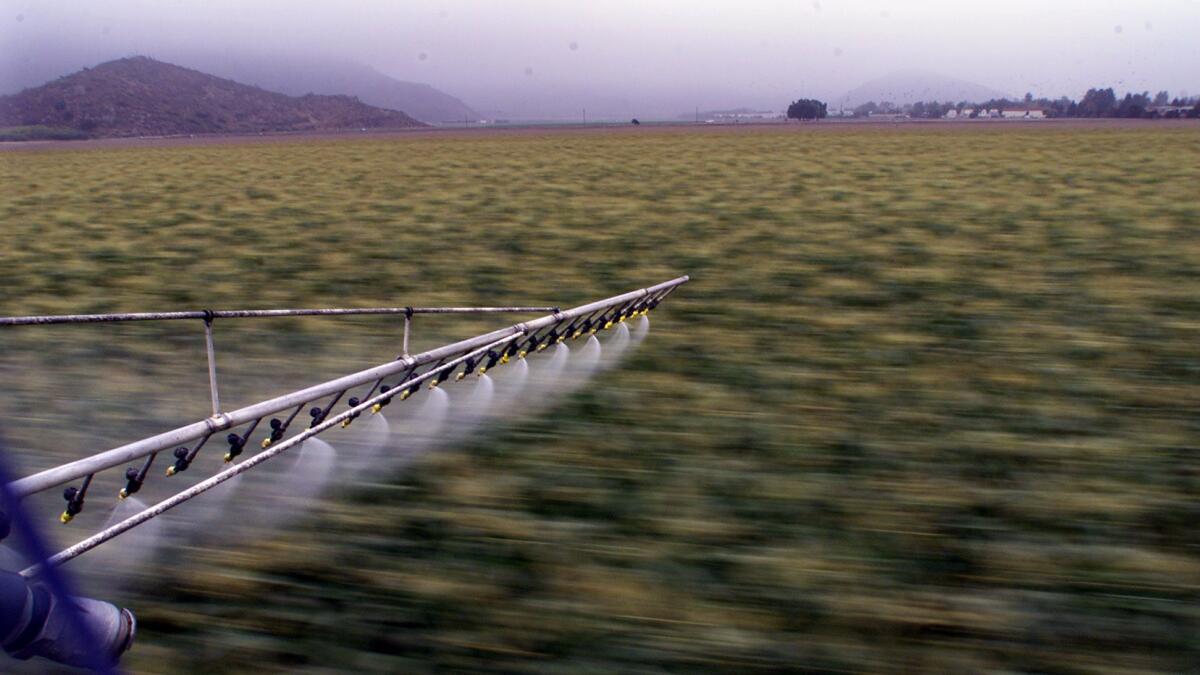California softens its proposed rule on pesticide use near schools

- Share via
Before using pesticides near California public schools, growers would have to notify school and county agricultural officials, under a revised draft regulation released Thursday — but the notification requirements would be less strenuous than what was proposed a few months ago.
In September, the California Department of Pesticide Regulation released a draft proposal that would ban crop dusting and many other forms of agricultural pesticide spraying within a quarter of a mile of public schools and day-care centers on weekdays between 6 a.m. and 6 p.m.
That original proposal said growers with fields within a quarter of a mile of school sites would have to provide officials with a list each year of all pesticides they expected to use, as well as a map showing the location of the field to be treated and other information.
The proposal also would have required growers to give officials 48 hours’ notice each time they sprayed pesticides in that quarter-mile zone.
The revised proposal retains the quarter-mile zone and the ban that stretches from 6 a.m. to 6 p.m. on weekdays.
Under the revised regulation, growers still would need to provide officials with an annual list of pesticides, but would have to provide 48 hours’ notice only before using pesticides that were not on their original list.
The updated proposal also clarifies the definition of “school sites” covered under these regulations; excluding, for example, school buses or bus stops that are not on school property.
Growers have said that there was no reliable science to justify such a wide zone and such lengthy bans on spraying, and that this would boost costs and hurt their ability to protect crops from pests.
Cynthia Cory, director of environmental affairs for the California Farm Bureau Federation, said the industry group supported a law passed in 2002 that gave counties’ agriculture commissioners the ability to regulate use of pesticides within a quarter of a mile of schools because that law allowed for local control. But the state’s September proposal went too far, she said.
“While [the proposal] might have been simplified a little bit, I still stand on the same premise,” she said of the revised regulation.
The revised proposal comes after months of public comment, including three formal hearings. The regulation would affect about 3,500 public K-12 schools and licensed day-care facilities, and involve about 2,500 growers in California, according to the Department of Pesticide Regulation.
“We believe this regulation will provide Californians with probably the most robust protection in the nation for schoolchildren when agricultural pesticides are applied near their school,” Brian Leahy, director of the Department of Pesticide Regulation, said in a statement.
The rule is expected to go into effect Jan. 1, 2018. It would be the first statewide rule governing how pesticides can be applied in areas in which farms are close to facilities where children gather, though many counties already have regulations aimed at preventing unintentional pesticide drift over these kinds of areas. Local governments can also pass their own rules, as long as they do not undercut a state baseline regulation.
Some say the revised draft does not go far enough.
Paul Towers, spokesman for environmental advocacy group Pesticide Action Network North America, said in an email that the proposed rule provides only “part-time protections” to students and that it does not provide “meaningful notification about when the actual applications take place.”
The department will seek public comment on the revised regulation until April 4.
Twitter: @smasunaga
UPDATES:
2:30 p.m.: This article was updated to include a comment from Cynthia Cory of the California Farm Bureau Federation.
1:15 p.m.: This article was updated to include a comment from Paul Towers of Pesticide Action Network North America.
This article was originally published at 10 a.m.
More to Read
Inside the business of entertainment
The Wide Shot brings you news, analysis and insights on everything from streaming wars to production — and what it all means for the future.
You may occasionally receive promotional content from the Los Angeles Times.











